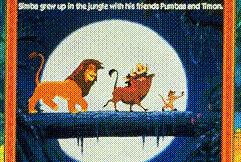






Reviewed on PowerMac 6100 with 8MB RAM and 2xCD
Our teachers felt that The Lion King is "a delightful version of the movie." The children who reviewed it, ages 4 - 10, all "enjoyed it and played it endlessly." However, the teachers stated it has little educational value as a reading program. Instead, they suggested that parents who are thinking of purchasing the Lion King should view it as a high-tech bedtime story device. Although it does not teach specific reading skills, it does successfully highlight reading as enjoyable and entertaining -- not a bad goal for pre-readers or beginning readers.

| Lion King | ||
|---|---|---|
| Educational Value | * * | |
| Methodology | * * | |
| Age Appropriate | * * * * | |
| Management Tools | n/a | |
| Classroom Value | * * | |
| Home Value | * * * | |
| TEACHER'S RATING | * * * |




 Reviews /Contents /Sponsors /Help
Reviews /Contents /Sponsors /HelpQuestions or comments regarding this service? webmaster.superkids.com
Copyright © 1995, 1996 Knowledge Share LLCAll rights reserved. Do not duplicate or redistribute in any form without prior written permission.